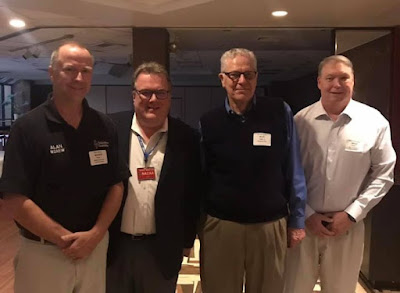Podcasting since 2005! Listen to Latest SolderSmoke
Saturday, December 4, 2021
Dean's Supercharged, 16-Watt, Furlough 2040, Simple SSB Rig
A Great Morning on the Old Military Radio Net: AB9MQ's Central Electronics 20A, W3EMD's Dynamotor, WU2D
I usually try to listen in on the Old Military Radio Net on Saturday mornings (3885 kc). Lately I listen with my Mate for the Mighty Midget receiver.
This morning's session was especially good. For me the highlight was when Masa AB9MQ called in from Normal, Illinois using his Central Electronics 20A (see below). That was one of the earliest SSB rigs. A phasing rig, it also ran AM (which was what Masa was using this morning). He had it paired up with a Central Electronics 458 VFO. You folks really need to check out Masa's QRZ.com page:
Buzz W3EMD called in from Rhinebeck, NY. I could hear his dynamotor in the background. Buzz said hello to Masa in Japanese. FB.
Always great to hear Mike WU2D.
Friday, December 3, 2021
Alan Wolke W2AEW: YouTube Silver Play Button Award, and ARRL Hudson Division 2020 Technical Achievement Award
Thursday, December 2, 2021
Peter Parker VK3YE Inducted Into QRP Hall of Fame
Thanks to VK3HN for alerting me to this.
Wednesday, December 1, 2021
KI4IO in India and Nepal, and Discrete Homebrew Gilbert Cells
While in India I was licensed at VU2LHO and worked a lot of US hams with a 135' flat-top and open-wire feed. I had the antenna strung between two bamboo towers atop the embassy housing 2nd-story roof-top. I also put up a 3/8 wave vertical on the roof for 10 meters. That little antenna had 110 radials stapled into the roof screen and worked very well! The rig was a HW-101. I was in Kathmandu, Nepal from early 1980 to late 1982. I could not obtain a license there, but became good friends with Father Moran, 9N1MM, and would often spend time up at his place putting his Drake station on CW. Pretty cool being real DX! Back in the states in late 1982.
Tuesday, November 30, 2021
Putting a Barebones Superhet on 17 Meters with an NE602 Converter (Video)
Sunday, November 28, 2021
How To Understand the NE-602 and the Gilbert Cell Mixer
Saturday, November 27, 2021
The Galway Radio Experimenters Club
Wednesday, November 24, 2021
Gloria -- A Netflix Series about a Shortwave Broadcast Station in Portugal
Rarely if ever will we come across a high quality NETFLIX series built around a shortwave broadcast transmitter. But that is what we have in Gloria. It is really good. We were especially interested in it because we lived in Portugal for three years. In addition to all the intrigue and drama you will catch glimpses of broadcast antennas, big transmitting tubes, and one out-of-focus shot of what appears to be a Hallicrafters receiver (SX-42?)
More info here:
Here's the NETFLIX link:
https://www.netflix.com/title/81073977
Thanks to Thomas K4SWL of SWLing Post for the heads up.
Tuesday, November 23, 2021
Jagadish Chandra Bose
Jagadish Chandra Bose








































